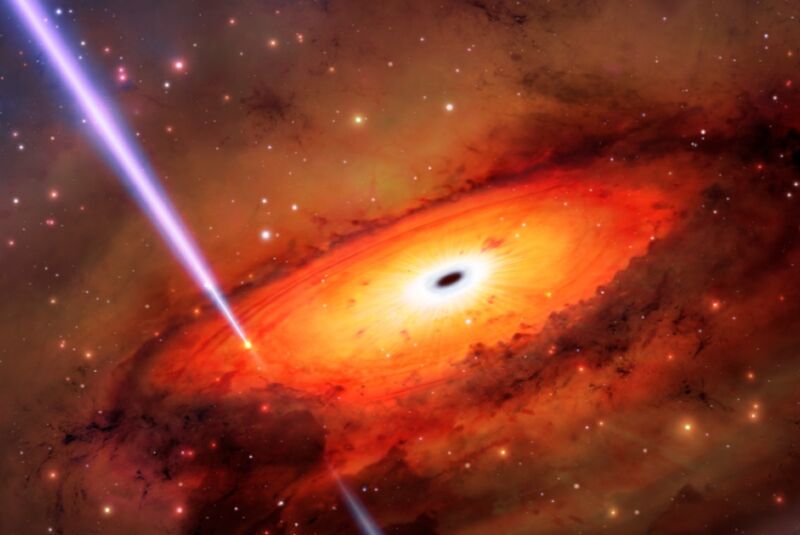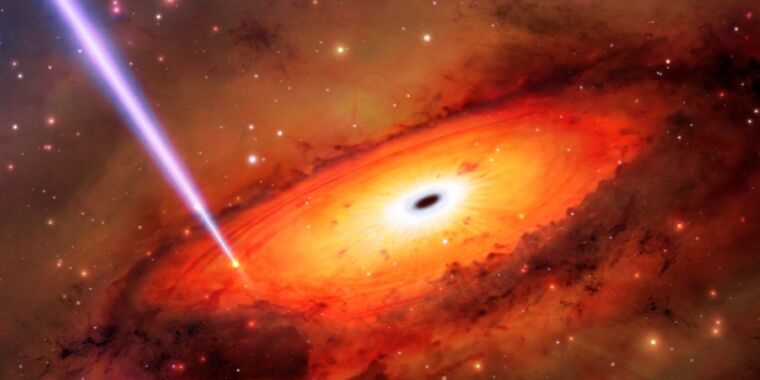
Int’l Gemini Observatory/NOIRLab/NSF/AURA/M. Garlic/M. Zamani
When astronomers saw a powerful gamma-ray burst (GRB) in October 2019, the most likely explanation was that it was produced by a massive dying star in a distant galaxy exploding in a supernova. But data from later observations showed that the outburst was caused by the collision of stars (or their remnants) in a densely packed region near the supermassive black hole of an ancient galaxy, according to a new paper published in the journal Nature Astronomy. Such a rare event has been hypothesized, but this is the first observational evidence for one.
As we previously reported, gamma-ray bursts are extremely energetic explosions in distant galaxies that last between a few milliseconds and a few hours. There are two classes of gamma-ray bursts. Most (70 percent) are long bursts of more than two seconds, often with a bright afterglow. These are usually associated with galaxies with rapid star formation. Astronomers think long bursts are linked to the death of massive stars that collapse to form a neutron star or black hole (or alternatively, a newly formed magnetar). The baby black hole would produce jets of highly energetic particles moving nearly at the speed of light, powerful enough to penetrate the remnants of the precursor star and emit X-rays and gamma rays.
Those gamma-ray bursts that last less than two seconds (about 30 percent) are considered short bursts, usually emitted in regions of very little star formation. Astronomers think these gamma-ray bursts are the result of mergers between two neutron stars or a neutron star merging with a black hole, consisting of a “kilonova”.
The gamma-ray burst detected by NASA’s Neil Gehrels Swift Observatory in 2019 fell into the long category. But astronomers were surprised to find no evidence of a corresponding supernova. “For every 100 events that fit the traditional classification scheme of gamma-ray bursts, there’s at least one oddball out there that fools us,” said study co-author Wen-fai Fong, an astrophysicist at Northwestern University. “However, it is these eccentrics who tell us the most about the spectacular diversity of explosions that the universe is capable of.”
Intrigued, Fong and his co-authors tracked the eruption’s fading afterglow using the International Gemini Observatory, supplemented by data collected by the Nordic Optical Telescopes and the Hubble Space Telescope. The afterglow allowed them to locate the GRB in an area just 100 light-years away from the core of an ancient galaxy, very close to the supermassive black hole at its center. They concluded that the outburst was caused by the collision of two stars or stellar remnants.
That’s important because there are three known processes by which a star dies, depending on its mass. Massive stars explode in a supernova, while a star with the mass of our own sun will shed its outer layers and eventually fade into a white dwarf. And the stellar remnants created from supernovas — neutron stars or black holes — can form binary systems and eventually collide.
Now we have a fourth alternative: stars in dense regions of old galaxies can collide – an event that is very rare in active galaxies, which are not so dense. An ancient galaxy could contain a million stars in an area of just a few light years. And in this case, the gravitational effects of being so close to a supermassive black hole would have altered the motions of those stars so that they moved in random directions. A collision would eventually be unavoidable.
In fact, the authors suggest that these types of collisions may not even be that rare; we just don’t detect the telltale GRBs and afterglows because of all the dust and gas obscuring our view of the centers of old galaxies. In the future, if astronomers could pick up a gravitational wave signature in conjunction with such a GRB, it could tell them more about this type of stellar death.
“These new results show that stars can meet their doom in some of the densest regions of the Universe where they can be driven into collision,” said study co-author Andrew Levan, an astronomer at Radboud University in the Netherlands. “This is exciting for understanding how stars die and answering other questions, such as what unexpected sources can create gravitational waves that we can detect on Earth.”
DOI: Natural Astronomy, 2023. 10.1038/s41550-023-01998-8 (About DOIs).

